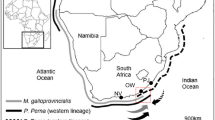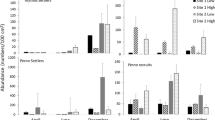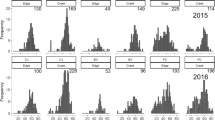Abstract
Recruitment and population structure of Perna perna in low shore mussel beds were investigated over 15 months at six sites along the south coast of South Africa. Initial, subjective classification of sites as wave exposed or wave sheltered (three of each) was confirmed using the dissolution of cement blocks to measure average water flux and dynamometers for maximum wave force. Recruitment occurred throughout the year, but recruit (1–5 mm) densities were significantly higher from January to April 1996 on both shore types. Recruit densities were positively correlated with adult (>15 mm) densities for both shore types (P < 0.05) but the correlations were extremely weak (r2 < 0.06 in each case). In areas with 100% cover, adult size (mean and maximum lengths) was greater on exposed sites, but density showed the reverse and was negatively correlated with maximum wave strength (r = −0.84). Despite differences in adult densities and sizes, biomass, which is a product of the two, showed no significant difference between the two shore types (ANOVA P > 0.05). Thus wave exposure dramatically affects density, recruitment and mussel size, but not recruitment timing or biomass where there is 100% cover, and mediates a three-way interaction among food supply, larval supply and intraspecific competition for space. In contrast to shores with saturation recruitment, mussel biomass here appears to be limited by recruit supply and constraints of food, especially on sheltered shores, while density is regulated through intraspecific competition for space primarily on exposed shores and at small spatial scales.










Similar content being viewed by others
References
Alvarado JL, Castilla JC (1996) Tridimensional matrices of mussels Perumytilus purpuratus on intertidal platforms with varying wave forces in central Chile. Mar Ecol Prog Ser 133:135–141
Ballantine WJ (1961) A biologically-defined exposure scale for the comparative description of rocky shores. Field Stud 1:1–19
Beckley LE (1979) Primary settlement of Perna perna (L.) on littoral seaweeds on St Croix Island. S Afr J Zool 14:171
Bertness MD, Gaines SD, Stephens SG, Yund PO (1992) Components of recruitment in populations of the acorn barnacle, Semibalanus balanoides (Linnaeus). J Exp Mar Biol Ecol 156:199–215
Bertness MD, Trussell GC, Ewanchuk PJ, Silliman BR, Crain CM (2003) Consumer-controlled community states on Gulf of Maine rocky shores. Ecology 85:1321–1331
Bustamante RH, Branch GM (1996a) The dependence of intertidal consumers on kelp-derived organic matter on the west coast of South Africa. J Exp Mar Biol Ecol 196:1–28
Bustamente RH, Branch GM (1996b) Large-scale patterns and trophic structure of southern African rocky shores: the roles of geographic variation and wave exposure. J Biogeogr 23:339–351
Connell JH (1985) The consequences of variation in initial settlement vs post-settlement mortality in rocky intertidal communities. J Exp Mar Biol Ecol 93:11–45
Connolly S, Menge BA, Rougharden J (2001) A latitudinal gradient in recruitment of intertidal invertebrates in the northeast pacific Ocean. Ecology 82:1799–1813
Crawford RJM, Bower DF (1983) Aspects of growth, recruitment and conservation of the brown mussel Perna perna along the Tsitsikamma coast. Koedoe 26:123–133
Denny MW (1987) Lift as a mechanism of patch initiation in mussel beds. J Exp Mar Biol Ecol 113:231–245
Denny MW, Gaines SD (1990) On the prediction of maximal intertidal wave forces. Limnol Oceanogr 35:1–15
van Erkom Schurink C, Griffiths CL (1990) Marine mussels of Southern Africa-their distribution patterns, standing stocks, exploitation and culture. J Shellfish Res 9:75–85
Erlandsson J, McQuaid CD (2004) Spatial structure of recruitment in the mussel Perna perna at local scales: effects of adults, algae and recruit size. Mar Ecol Prog Ser 267:173–185
Erlandsson J, Pal P, McQuaid CD (2006) Re-colonisation rate differs between co-existing indigenous and invasive intertidal mussels following major disturbance. Mar Ecol Prog Ser 320:169–176
Gaylord B (2000) Biological implications of surf zone complexity. Limnol Oceanogr 45:174–188
Grant J, Dowd M, Thompson K, Emerson C, Hatcher A (1993) Perspectives on field studies and related biological models of bivalve growth and carrying capacity. In: Dame RF (ed) Bivalve filter feeders in estuarine and coastal ecosystem processes. Series G, vol. 33 Springer, Heidelberg, pp 371–420
Griffiths RJ (1981) Population dynamics and growth of the bivalve Choromytilus meridionalis (Kr.) at different tidal levels. Estuar Coast Shelf Sci 12:101–118
Griffiths CL, Hockey PAR (1987) A model describing the interactive roles of predation, competition and tidal elevation in structuring mussel populations. S Afr J Mar Sci 5:547–556
Hammond W, Griffiths CL (2004) Influence of wave exposure on South African mussel beds and their associated infaunal communities. Mar Biol 144:547–552
Harger JRE (1970) The effect of wave impact on some aspects of the biology of sea mussels. Veliger 12:401–414
Harger JRE, Landenberger DE (1971) The effect of storms as a density dependent mortality factor on populations of sea mussels. Veliger 14:195–201
Harris JM, Branch GM, Elliott BL, Currie B, Dye A, McQuaid CD, Tomalin B, Velasquez C (1998) Spatial and temporal variability in recruitment of intertidal mussels around the coast of southern Africa. S Afr J Zool 33:1-11
Hepburn HR, Sinclair GS, Davidoff MR, Moss EA, Chandler HD, Ripley S (1979) Byssus threads and their tenacity. S Afr J Sci 75:187–189
Hughes TP (1990) Recruitment limitation, mortality, and population regulation in open systems: a case study. Ecology 71:12–20
Hughes RN, Griffiths CL (1988) Self-thinning in barnacles and mussels: the geometry of packing. Am Nat 132:484–491
Hunt HL, Scheibling RE (2000) Movement and wave dislodgement of mussels on a wave-exposed rocky shore. Veliger 45:273–277
Jenkins SR, Aberg P, Cervin G, Coleman RA, Delany J, Della Santina P, Hawkins SJ, LaCroix E, Myers AA, Lindegarth M, Power AM, Roberts MF, Hartnoll RG (2000) Spatial and temporal variation in settlement and recruitment of the intertidal barnacle Semibalanus balanoides (L.) (Crustacea: Cirripedia) over a European scale. J Exp Mar Biol Ecol 243:209–225
Jones WE, Demetropoulos A (1968) Exposure to wave action: measurements of an important ecological parameter on rocky shores on Anglesey. J Exp Mar Biol Ecol 2:46–63
Jørgensen CB (1976) Growth efficiencies and factors controlling size in some mytilid bivalves, especially Mytilus edulis L.: review and interpretation. Ophelia 15:175–192
Kautsky N (1982) Growth and size structure in a Baltic Mytilus edulis population. Mar Biol 68:117–133
Lasiak T (1991) The susceptibility and/or resilience of rocky littoral molluscs to stock depletion by the indigenous coastal people of Transkei, Southern Africa. Biol Conserv 56:245–264
Lasiak TA (1993) The shellfish gathering practises of indigenous people in Transkei: patterns, preferences and perceptions. S Afr J Ethnol 16:115–120
Lasiak TA, Barnard TCE (1995) Recruitment of the brown mussel Perna perna onto natural substrata: a refutation of the primary/secondary settlement hypothesis. Mar Ecol Prog Ser 120:147–153
Lawrie SM, McQuaid CD (2001) Scales of mussel bed complexity: structure, associated biota and recruitment. J Exp Mar Biol Ecol 257:135–161
McKindsey CW, Bourget E (2000) Explaining mesoscale variation in intertidal mussel community structure. Mar Ecol Prog Ser 205:155–170
McQuaid CD, Branch GM (1985) Trophic structure of rocky intertidal communities: response to wave action and implications for energy flow. Mar Ecol Prog Ser 22:153–161
McQuaid CD, SM Lawrie (2005) Supply-side ecology of the brown mussel, Perna perna: an investigation of spatial and temporal variation in, and coupling between, gamete release and larval supply. Mar Biol 147:955–963
McQuaid CD, Lindsay TL (2000) The effects of wave exposure on growth and mortality rates of the mussel Perna perna: bottom-up regulation of intertidal populations. Mar Ecol Prog Ser 206:147–154
McQuaid CD, Phillips TE (2006) Mesoscale variation in reproduction, recruitmentand population structure of intertidal mussels with low larval input: a bay/open coast comparison. Mar Ecol Prog Ser 327:193–206
McQuaid CD, Lindsay JR, Lindsay TL (2000) Interactive effects of wave exposure and tidal height on population structure of the brown mussel Perna perna. Mar Biol 137:925–932
Menge BA (1983) Components of predation in the low zone of the New England rocky intertidal region. Oecologia 58:141–155
Menge BA (1991) Relative importance of recruitment and other causes of variation in rocky intertidal community structure. J Exp Mar Biol Ecol 146:69–100
Palumbi SR (1984) Measuring intertidal wave force. J Exp Mar Biol Ecol 81:171–179
Peterson CH, Beal BF (1989) Bivalve growth and higher order interactions: importance of density, site and time. Ecology 70:1390–1404
Petraitis PS (1991 Recruitment of the mussel Mytilus edulis L. on sheltered and exposed shores in Maine, USA. J Exp Mar Biol Ecol 147:65–80
Petraitis PS (1995) The role of growth in maintaining spatial dominance by mussels Mytilus edulis. Ecology 76:1337–1346
Rius M, McQuaid CD (2006) Wave action and competitive interaction between the invasive mussel Mytilus galloprovincialis and the indigenous Perna perna in South Africa. Mar Biol 150:59–78
Seed R (1969) The ecology of Mytilus edulis L. (Lamellibranchiata) on exposed rocky shores II. Growth and mortality. Oecologia 3:317–350
Seed R, Brown RA (1978) Growth as a strategy for survival in two marine bivalves, Cerastoderma edule and Modiolus modiolus. J Anim Ecol 47:283–292
Steffani CN, Branch GM (2003) Growth rate, condition, and shell shape of Mytilus galloprovincialis: responses to wave exposure. Mar Ecol Prog Ser 246:197–209
Zar JH (1996) Biostatistical analysis, 3rd edn. Prentice-Hall Inc., New Jersey
Zardi GI, Nicastro KR, McQuaid CD, Rius M, Porri F (2006) Hydrodynamic stress as a determinant factor in habitat segregation between the indigenous mussel Perna perna and the invasive Mytilus galloprovincialis in South Africa. Mar Biol 150:79–88
Acknowledgments
We gratefully acknowledge funding from the National Research Foundation of South Africa and Rhodes University. This research complied with the laws of South Africa.
Author information
Authors and Affiliations
Corresponding author
Additional information
Communicated by C.L. Griffiths.
Rights and permissions
About this article
Cite this article
McQuaid, C.D., Lindsay, T.L. Wave exposure effects on population structure and recruitment in the mussel Perna perna suggest regulation primarily through availability of recruits and food, not space. Mar Biol 151, 2123–2131 (2007). https://doi.org/10.1007/s00227-007-0645-9
Received:
Accepted:
Published:
Issue Date:
DOI: https://doi.org/10.1007/s00227-007-0645-9




